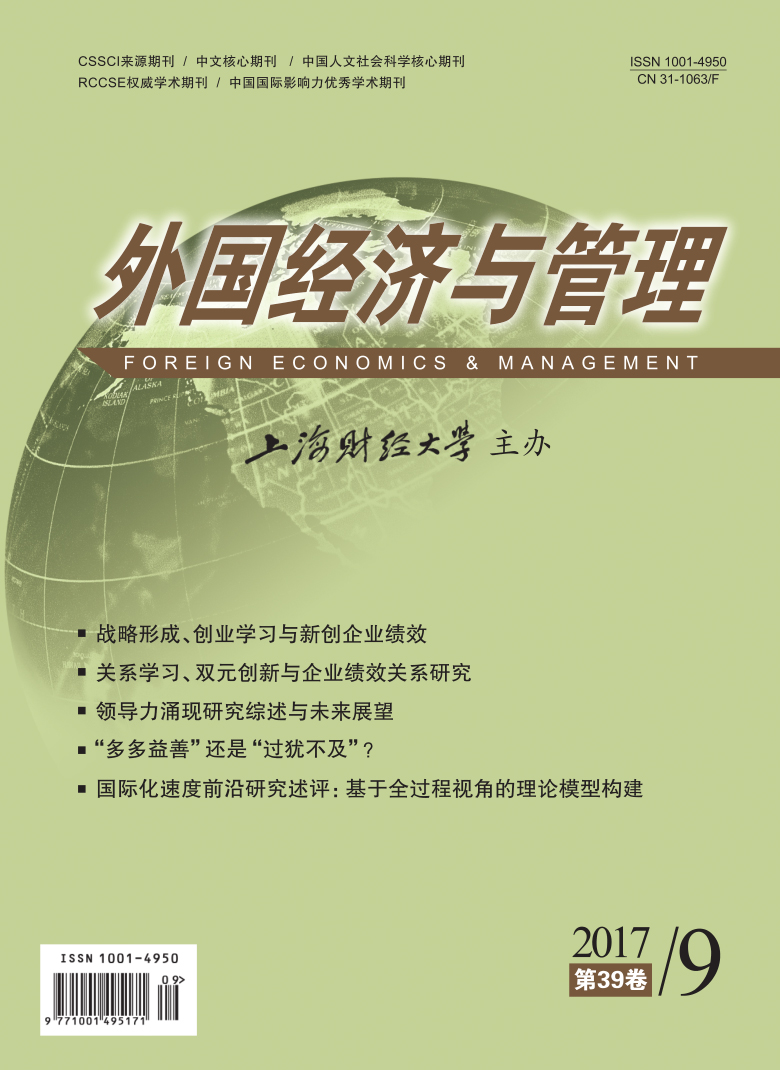海外移民创业网络与东道国集群网络的协同演化是在“走出去”战略中赢得主动的重要举措。移民企业家既期望从东道国集群网络中获取创新资源,也需要通过与周围环境实施一定程度的隔离来规避风险。借助案例研究,以普拉托温州移民创业网络的演化历程为载体,探究移民创业网络和东道国产业集群网络的演化历程,分析网络协同演化过程中的三类距离(制度距离、能力距离和文化距离)与隔离状态之间的变化规律。研究发现,网络协同演化过程中充斥着利益博弈,导致距离将始终存在;虽然距离将会导致隔离,但是距离最优并不意味着隔离状态发生的概率最小,且文化距离能够前瞻性地预测隔离状态发生的可能性。现阶段需要设法降低三类距离,特别是降低文化距离,以弱化保护性隔离策略的实施动机并促进移民创业网络与东道国集群网络的协同演化。
距离会导致隔离吗?——海外移民创业网络与东道国集群网络的演化案例研究
摘要
参考文献
1 Ambrosini M. Immigration in Italy: Between economic acceptance and political rejection[J]. Journal of International Migration and Integration, 2013, 14(1): 175–194.
2 Barreto I. Dynamic capabilities: A review of past research and an agenda for the future[J]. Journal of Management, 2010, 36(1): 256–280. DOI:10.1177/0149206309350776
3 Cezar R, Escobar O R. Institutional distance and foreign direct investment[J]. Review of World Economics, 2015, 151(4): 713–733. DOI:10.1007/s10290-015-0227-8
4 Dolfsma W, Eijk R. Distances in organizations: Innovation in an R&D lab[J]. British Journal of Management, 2015, 27(2): 271–286.
5 Du Y M. Institutional distance and location choice of multinational enterprises [D]. Singapore: Singapore Management University, 2009.
6 Egbetokun A, Savin I. Absorptive capacity and innovation: when is it better to cooperate?[M]//The Evolution of Economic and Innovation Systems. Springer International Publishing, 2015: 373–399.
7 Eisenhardt K M, Graebner M E. Theory building from cases: Opportunities and challenges[J]. Academy of Management Journal, 2007, 50(1): 25–32. DOI:10.5465/AMJ.2007.24160888
8 El Bouk F, Vedder P, Poel Y. The networking behavior of Moroccan and Turkish immigrant entrepreneurs in two Dutch neighborhoods: The role of ethnic density[J]. Ethnicities, 2013, 13(6): 771–794. DOI:10.1177/1468796812471131
9 Estrin S, Baghdasaryan D, Meyer K E. The impact of institutional and human resource distance on international entry strategies[J]. Journal of Management Studies, 2009, 46(7): 1171–1196. DOI:10.1111/joms.2009.46.issue-7
10 Fatoki O, Oni O. The networking behaviour of immigrant entrepreneurs in South Africa[J]. Mediterranean Journal of Social Sciences, 2014, 5(20): 284–290.
11 Gaur A S, Delios A, Singh K. Institutional environments, staffing strategies, and subsidiary performance[J]. Journal of Management, 2007, 33(4): 611–636. DOI:10.1177/0149206307302551
12 Gilsing V, Nooteboom B, Vanhaverbeke W, et al. Network embeddedness and the exploration of novel technologies: Technological distance, betweenness centrality and density[J]. Research Policy, 2008, 37(10): 1717–1731. DOI:10.1016/j.respol.2008.08.010
13 Hall P, Wylie R. Isolation and technological innovation[J]. Journal of Evolutionary Economics, 2014, 24(2): 357–376. DOI:10.1007/s00191-014-0347-7
14 Herman R T, Smith R L. Immigrant, Inc.: why immigrant entrepreneurs are driving the new economy(and how they will save the American worker)[M]. New York: John Wiley & Sons, 2009.
15 Hoang H, Antoncic B. Network-based research in entrepreneurship: A critical review[J]. Journal of Business Venturing, 2003, 18(2): 165–187. DOI:10.1016/S0883-9026(02)00081-2
16 Hofstede G, Bond M H. The Confucius connection: From cultural roots to economic growth[J]. Organizational Dynamics, 1988, 16(4): 5–21. DOI:10.1016/0090-2616(88)90009-5
17 Human S E, Provan K G. Legitimacy building in the evolution of small-firm multilateral networks: A comparative study of success and demise[J]. Administrative Science Quarterly, 2000, 45(2): 327–365. DOI:10.2307/2667074
18 Kogut B, Singh H. The effect of national culture on the choice of entry mode[J]. Journal of International Business Studies, 1988, 19(3): 411–432. DOI:10.1057/palgrave.jibs.8490394
19 Kostova T. Success of the transnational transfer of organizational practices within multinational companies[D]. Minnesota: University of Minnesota, 1996: 9–21.
20 Kudic M. Innovation networks in the German laser industry: evolutionary change, strategic positioning, and firm innovativeness[M]. Switzerland: Springer, 2014.
21 Molina-Morales F X, Martínez-Fernández M T, Coll-Serrano V. Efficiency and Innovation in Sub-Networks of Companies: A Study of the Spanish Ceramics District[J]. Innovar, 2012, 22(46): 111–128.
22 Nooteboom B, Van Haverbeke W, Duysters G, et al. Optimal cognitive distance and absorptive capacity[J]. Research Policy, 2007, 36(7): 1016–1034. DOI:10.1016/j.respol.2007.04.003
23 Peng M W. Towards an institution-based view of business strategy[J]. Asia Pacific Journal of Management, 2002, 19(2–3): 251–267.
24 Peng M W, Wang D Y L, Jiang Y. An institution-based view of international business strategy: A focus on emerging economies[J]. Journal of International Business Studies, 2008, 39(5): 920–936. DOI:10.1057/palgrave.jibs.8400377
25 Phillips N, Tracey P, Karra N. Rethinking institutional distance: strengthening the tie between new institutional theory and international management[J]. Strategic Organization, 2009, 7(3): 339–348. DOI:10.1177/1476127009337439
26 Rottig D. Institutional distance, social capital, and the performance of foreign acquisitions in the United States[D]. Florida: Florida Atlantic University, 2008.
27 Schilirò D. I distretti industriali in Italia quale modello di sviluppo locale: aspetti evolutivi, potenzialità e criticità[M]. Vita e pensiero, 2008.
28 Schot J, Geels F W. Niches in evolutionary theories of technical change[J]. Journal of Evolutionary Economics, 2007, 17(5): 605–622. DOI:10.1007/s00191-007-0057-5
29 Slotte-Kock S, Coviello N. Entrepreneurship research on network processes: A review and ways forward[J]. Entrepreneurship Theory and Practice, 2010, 34(1): 31–57. DOI:10.1111/etap.2010.34.issue-1
30 Turkina E, Thai M T T. Social capital, networks, trust and immigrant entrepreneurship: a crosscountry analysis[J]. Journal of Enterprising Communities: People and Places in the Global Economy, 2013, 7(2): 108–124. DOI:10.1108/17506201311325779
31 Witt U. Evolution as the theme of a new heterodoxy in economics[J]. Explaining Process and Change. Approaches to Evolutionary Economics, 1992: 3–20.
32 Yin R K. Case study research: Design and methods[M]. 5th ed. Calif: SAGE Publications, 2013.
33 Zhang Y, Li H. Innovation search of new ventures in a technology cluster: the role of ties with service intermediaries[J]. Strategic Management Journal, 2010, 31(1): 88–109. DOI:10.1002/smj.v31:1
引用本文
张敏, 张一力. 距离会导致隔离吗?——海外移民创业网络与东道国集群网络的演化案例研究[J]. 外国经济与管理, 2017, 39(9): 16–31.
导出参考文献,格式为:





 9813
9813  9344
9344

